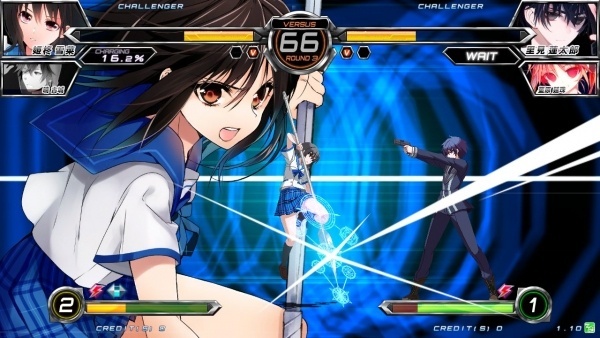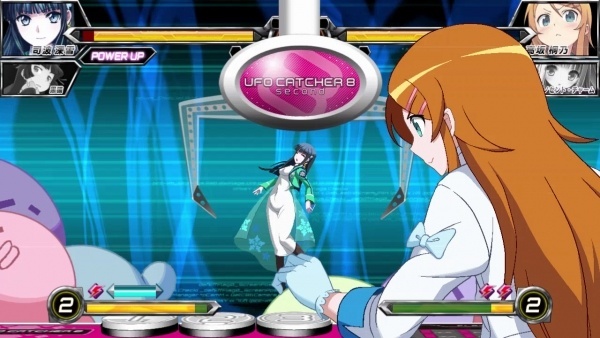Dengeki Bunko: Fighting Climax (PS Vita) Review
By Nikola Suprak  05.10.2015
05.10.2015

Crossover titles frequently end up being somewhat of a mess. The emphasis on these sorts of titles tends to be little more than pointing at two characters from two different games and going, "Hey, isn't that cool?" Dengeki Bunko: Fighting Climax is a fighter that serves as a crossover of a variety of characters published under ASCII Media Works' Dengeki Bunko imprint. As a tribute to Dengeki Bunko, it certainly succeeds and fans of the various light novels featured here might want to check this out solely for the novelty factor. As a game, though, it is considerably less impressive, but people wanting to see Miyuki Shiba wail on Asuna don't have a tremendous amount of alternatives.
Fighting games are known for their story in the same way a spilled can of alphabet soup is, and Dengeki Bunko: Fighting Climax is somehow even less entertaining and coherent than that. Each character's tale is divided between two different modes: arcade and dream. Arcade Mode is essentially the 'by the numbers' fighter story, with the big bad this time around being some sort of world conquering entity that can shift between forms of heroes from the worlds he's conquered. Whichever character is selected happens to be the very last hope for this universe, and they must battle all the previous vanquished heroes in an effort to free them and prevent their own world from being absorbed. The story here is entirely forgettable and a bit silly, and it quickly becomes apparent that a preferable alternative is to just mash buttons to get through all the terrible dialogue as quickly as possible.

Dream Mode is a bit more entertaining because it really focuses on what the game is all about: fan-service. There are a handful of other characters to select once the fighter is chosen that open little vignettes between the playable character and their opponent. These tend to be cute little scenes and while they feel a bit like some weird fan-fiction pulled off of the depths of the Internet at times, there is something fun about seeing a character from Sword Art Online chat it up with another from A Certain Magical Index. The vignettes themselves don't really lead into the fights that often and, for example, one of them has a younger girl talking about how she admires the strength of another character. After a nice little exchange they start slapping each other because it is… what they do. The fights feel like a non-sequitur at times, but the little crossover scenes preceding them should at least entertain fans of the respective series.
The main appeal here is clearly the spectacle of it all, and on that front it succeeds wholeheartedly. There is an interesting cross-section of characters here, although it largely takes place amongst the background of various unrelated SEGA properties, which is slightly strange. Environments pulled from things like Sonic the Hedgehog stages end up feeling a bit out of place. Fortunately, between Dengeki Bunko and SEGA, there are a lot of references and winks to a wide variety of other properties, and it is fun seeing them all come together in one cohesive (if a bit unruly) package. A lot of the moves are clever nods to stuff that happened in the source material, and the amount of effort that went into making the characters feel like the actual characters is fantastic. The worry for titles like this is the personnel end up looking like the source material but feeling and controlling like generic fighter character #2381, which is something that is luckily not a problem here.

A lot of effort clearly went into making this reflect the source material, but, unfortunately, far less work seems to have gone into making this a well-polished fighter. There are some interesting twists here, but a lot of the features have been used elsewhere (and in a better way) many times before. There is a basic fighting system that utilises various combinations of weak, medium, and strong attacks and each character has a couple of different special moves. In addition to the main, playable character, there are a ton of assists to choose from that each have two separate attacks and add an extra little bit of complexity. A climax bar comes into play, which can build up over the course of a battle or get a quick boost with the use of a special command. These allow the fighters to use some absolutely devastating moves, while other special moves known as Trump Cards allow for even more advantages when used at the right time.
While it sounds like there is a lot to learn, this is actually one of the easiest fighters to get into currently available on the Vita. A lot of the important moves can be used with the push of a single button, and both the Trump Cards and quick boost to the climax bar come with the press of a shoulder button. Furthermore, almost every single character has the same basic control scheme, meaning it is easy to jump from one to the other without having to completely re-learn the character. The simplicity here is a bit of double-edged sword, and things are clearly geared a bit more towards the casual crowd. There is no huge learning curve to picking up any of the characters, and it is certainly a title that welcomes in basically anyone who might be a fan of the source material. At the same time, though, the lack of any real depth to the fighting makes this ultimately a bit forgettable. There isn't much reason for hardcore fighting fans to keep revisiting this like the best genre stable-mates out there when pretty much any character can be mastered over the span of a couple of days. There are a lot of interesting ideas here, but many of them feel somewhat superficial and this is a fighter that is more about style than substance.

This certainly isn't a bad, and there is a certain amount of mindless fun to be had with some of the characters' really unique and bizarre moves. It just feels like more could have been done to polish it up further, and even the most basic aspects of the design here are a bit wanting. The roster itself is a bit lacking, and while the number of characters included is impressive, many of those are only assist characters. The playable roster is pretty small, and even worse is the fact it isn't balanced particularly well. While this is an issue in even the best of fighting games, the difference here seems particularly stark and a handful of characters are significantly less useful in battle. This issue seems even more pronounced in the assists, and a good chunk of them wind up being almost utterly useless. There are some that do low damage and attack a small area, while others seem to have the ability to hit half of the screen quick and hard. The original roster here isn't that huge to begin with, and then quickly becomes even smaller when the bad characters are thrown out.

Cubed3 Rating
Average
Dengeki Bunko: Fighting Climax falls a bit short on just about every metric worth mentioning in a fighting game. It isn't terrible, and novices at the genre might appreciate a game like this that is very easy to get into and doesn't have a daunting learning curve to master any of the characters. Truly, though, this is more of a game for fans of the various anime shows featured in it, as the fighting is clearly an afterthought. Poorly balanced characters and fairly uninspired combat system leave this sorely wanting, and anyone that has any real experience in the genre is likely to get bored quickly. Simply put, Dengeki Bunko: Fighting Climax is a fighting game for people that don't really like fighting games. The Vita library might not be huge, but one genre it certainly isn't lacking in is fighters and with so many better options out there, something this basic is hard to recommend as anything other than as a novelty to anime fans.
Comments
Comments are currently disabled

 Sign In
Sign In Game Details
Game Details
 None
None  Out now
Out now  Out now
Out now  None
None  Subscribe to this topic
Subscribe to this topic Features
Features





 Top
Top

